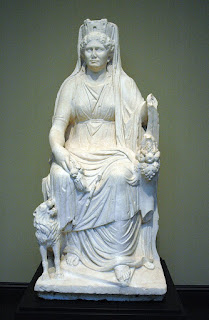He is described as pulling straw out of her hair and saying that if he could afford it, he would crown her with a "Jerusalem of Gold" – a "headgear shaped like the battlements or towers of a city", which was worn by "women of high status"...
Is this just a random innocent love scene? Or is there something more here, hidden in plain sight? I think the latter...
In my post about the sacred marriage on the threshing floor, I mentioned this:
"Threshing floors were used for religious ceremonies in Mesopotamia too. The annual sacred marriage reenactment between Ea and Ishtar (Asherah) was performed on a threshing floor".
You know how Asherah was associated with "High places"...Were these originally threshing floors?
As you can see from this article, the choice of the two protagonists of the scared marriage ceremony (sex) is not random. They mark the beginning (Ea- Apr/May) and the end (Ishtar - Jul/Aug) of the grain harvest in Mesopotamia...
Interestingly, the main consort of Ishtar (Inanna) was Tamuz (Dumuzid, Dumuzi), Mesopotamian god associated with shepherds...Whose sister Geshtinanna, was conveniently, the goddess of agriculture...
Ishtar, the queen of heaven, the morning star, is often depicted standing on a lion with the sun above it...
Why? Cause Jul/Aug, Leo, is the time when Sirius rises in the morning with the sun...
Anyway, Ishtar was not the only goddess that that stands on a lion, stands between lions, is driven in a chariot pulled by lions, or sits on a throne between two lions (all meaning "in Leo")...There is one for everyone in the audience, and I listed most of them in my post "Assumption of Mary"...
One of these lion goddesses was Cybele. Here she is, enthroned, with her pet lion, holding cornucopia, and wearing a "crown depicting city walls"!!!. This is a Roman marble made c. 50 AD...
Now Cybele was in turn associated with Greek Demeter, the Grain goddess. The main ceremony of her festivals called Haloa (from "halōs", "threshing floor"), took place in Eleusis, at the threshing floor of Triptolemus, Demeter's first priest and inventor of grain agriculture...
Romans knew Demeter as Ceres, Roman goddess of grain and grain harvest. Here she is, holding a sickle, with ears of grain in her hair and a grain sheaf in her hands...3rd century AD, Roman from Uthina, Tunisia...
Sooooo...After having sex with his wife on a threshing floor, Akkiva, the shepherd, picks the grain out of her hair and promises that he will buy her a golden crown in a shape of city walls...Scene depicting an Ordinary Marriage or a Sacred Marriage? What's going on here?
It's a mess, right?





No comments:
Post a Comment